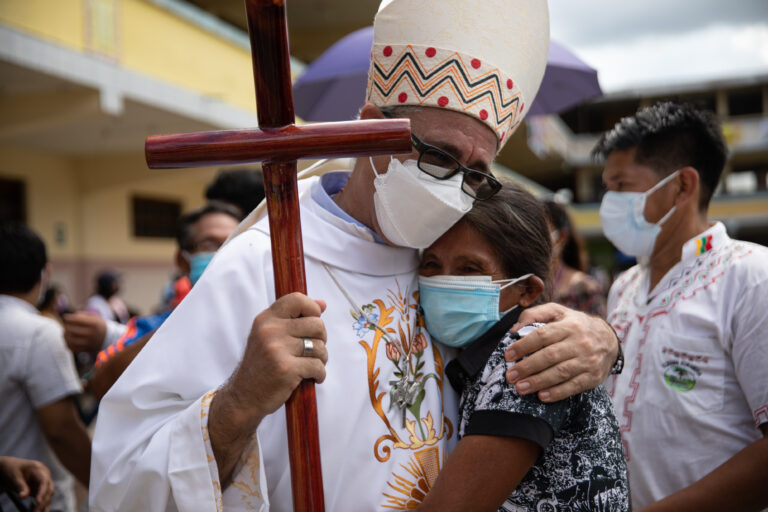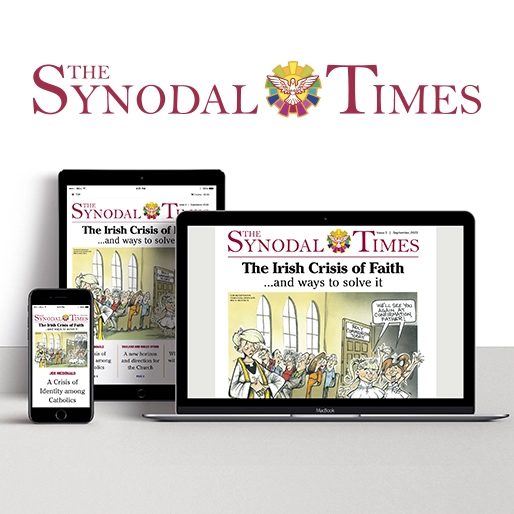The ministry of Spanish Augustinian friars Miguel Ángel Cadenas and Manolo Berjón in Peru’s northern Amazon region has been marked by water. As pastors in the rural parish of Santa Rita de Castillo, they made periodic visits to several towns and scores of tiny, mainly indigenous villages along the banks of the Marañón River and some of its tributaries in one of the most remote parts of the Catholic Vicariate of Iquitos.
They shared their parishioners’ fears as oil spills from barges and an aging pipeline ruined fisheries on which people depended for food and income and fouled the places where families bathed, washed clothes and drew water for drinking and cooking.
People of the water
“Many Amazonian peoples are people of the water,” says Cadenas, who was consecrated bishop of Iquitos in 2021. “The river is not simply a stream of water, and water is not only for drinking. The river is also gente,” a person. And for the Kukama people who live along its banks, it is the dwelling place of river spirits who communicate with relatives on land or respond when shamans call on them for healing powers.
Rapid social changes in Peru’s Loreto region, where the Iquitos Vicariate is based in the second-largest city in the entire Amazon basin, immersed the priests in a string of river-related issues. At twice-yearly workshops for village apus, or presidents, and animadores cristianos, the lay leaders of Catholic communities in the mainly indigenous villages, they discussed impacts of the oil spills and a plan to dredge shallow spots in the river to improve navigation, which Berjón predicted would bring more problems than benefits to the riverside communities.
Water issues took a new turn for the two priests when they moved from Santa Rita to the city of Iquitos in 2015. In their parish, where thousands of people lived in houses built on stilts over seasonally flooded wetlands, an open sewer spewed effluent from the city, a hospital and a slaughterhouse past the doors, and sometimes over the floorboards, of houses in several neighborhoods that lacked running water and sewer systems.
A lawsuit in that case, supported by the vicariate, is still before Peruvian courts, as is a demand by an organization of Kukama Indigenous women that the Marañón River be recognised as having rights.
Linking the rural and urban Amazon
In their journey from the rural part of Peru’s Loreto region to the regional capital of half a million people, Cadenas and Berjón followed a path taken by many of their parishioners, and one which poses new pastoral challenges.
Despite the region’s abundant water, nearly half Loreto’s population lacks safe drinking water, and most rural communities lack sanitation systems. Most of the economy is informal, and many people live day to day on scant earnings from irregular jobs. The region trails the country in health care and education rankings.
Like most Amazonian cities, Iquitos has a population of mixed ethnic background “There are multiple identities,” Berjón says, and they are not always readily visible. “Habitually, people in the city don’t identify as indigenous, because it can bring disadvantages, particularly discrimination,” Cadenas says. But if they see an advantage — the chance of a scholarship, or some other benefit — people may acknowledge their indigenous roots.
Indigenous heritage
Even people who deny having an indigenous heritage sow certain plants beside their houses for protection from evil spirits, and families turned to plant remedies during the height of the COVID-19 pandemic, when Western medicine offered few options. “Indigenous ideas rule in an Amazonian city,” Cadenas says.
One of those is shamanism. A shaman can cure the sick, provide guidance for the future and fight invisible spirits that threaten to harm a person. When they are strong, people follow them; when they are weak, their followers turn to others.
Not only do many people seek out a shaman instead of consulting a doctor at a local health center, but their relationship with shamans also shapes their view of politicians and religious figures, including priests.
Seventeenth-century Jesuit chroniclers wrote that some of the most successful missionaries had shamanic traits, Cadenas says. That makes priests and evangelical ministers important figures, who are seen as possessing knowledge and power that can help people. “It’s not the Western idea” of priesthood, Cadenas says. “It’s a matter of having people’s trust.”
As bishop, Cadenas ponders the implications of those realities not just for one rural or urban parish, but for the entire vicariate. Nevertheless, Loreto’s rural and urban worlds are closely linked, as people move back and forth between riverside villages and urban shantytowns.
The region is plagued by corruption, drug crop cultivation and narcotrafficking, illegal gold mining, illegal logging, pollution from aging oil fields and opposition to setting swaths of forested area aside to protect nomadic indigenous groups that continue to shun contact with wider Peruvian society. Deforestation rates are still relatively low, but that is likely to change as the road network expands.
Following Pope Francis’ dreams
Cadenas has been outspoken on environmental issues, drawing fire from some local media and occasionally from within the church. But his concerns echo those Pope Francis mentioned in his speech to several thousand indigenous people from around the Amazon basin who gathered in the southeastern Peruvian town of Puerto Maldonado during the papal visit in January 2018.
“The native Amazonian peoples have probably never been so threatened on their own lands as they are at present,” the Pope told his audience, as he recited the litany of extractive enterprises that have ravaged Amazonia since European colonizers arrived.
One of the few topics he did not address in that speech was the situation of urban indigenous people, an oversight corrected at the 2019 Synod on the Pan-Amazon Region. In “Querida Amazonia,” the papal exhortation resulting from that synod, Pope Francis described his dreams of a region where the rights of the poor and original peoples are respected and their voices are heard; a region that preserves its cultural riches and natural beauty; and committed Christian communities that give the church “new faces with Amazonian features”.
The Amazon Synod grew out of the Pope’s evolving understanding of the region’s environmental issues and pastoral challenges, an awareness sparked by discussions at the Fifth General Conference of Bishops of Latin America and the Caribbean in Aparecida, Brazil, where then-Cardinal Jorge Bergoglio oversaw the drafting of the final document.
At Aparecida, the Brazilian bishops, especially, called attention to the situation in the Amazon, where indigenous and other traditional communities faced discrimination and sometimes death for defending their territory, and where there were far too few church workers to cover the vast area.
Decline
With missionary vocations and donations in decline, the church needs new models that draw on local personnel — a theme at the Amazon Synod. Although they grabbed headlines, proposals for women deacons and the ordination of older, married men who could celebrate the Eucharist in communities that see priests only rarely, if at all, failed to make it into the papal exhortation.
Nevertheless , the Amazon Synod set other processes in motion. Local and regional assemblies held throughout the region in the months before the synod served as a model for similar gatherings leading up to the First Ecclesial Assembly of Latin America and the Caribbean in November 2021.
That event, which brought lay people, clergy and religious together in person and virtually, in turn was a proving ground for the listening process that has served as the first stage of the Synod on Synodality, to be held later this year at the Vatican.
Unrest a challenge for the Church
The two synods and the ecclesial assembly, as well as the Ecclesial Council for the Amazon, which grew out of the Amazon Synod, are efforts to make the Church less clerical and more participatory. But those processes take time, and the pace of social changes is testing the church’s ability to adapt.
The vicariate has established a permanent diaconate, but the first ordinations are still years away. Meanwhile, if a priest retires, dies or leaves, there is unlikely to be a replacement at hand. And social demands have become more acute.
In a country that was woefully underprepared for a pandemic, Iquitos was one of the cities that suffered most when COVID-19 struck. With its crowded shantytowns and hand-to-mouth economy — and with a shortage of oxygen generating plants — the city had one of the country’s highest mortality rates.
The emergency is past now, but the inequities have deepened. Cadenas and Berjón worry about the children who never returned to school, as well as the chronically inadequate health care and education.
Those inequities also afflict the Andean highlands, which erupted in protests when former President Pedro Castillo, a rural teacher and farmer from the northern Cajamarca region, who was elected in 2021, was impeached on 7 December 2022 after he attempted to shutter Congress and rule by decree.
The protests against his successor, President Dina Boluarte, who had been Castillo’s vice president, continue, although they have dwindled in recent weeks. Police crackdowns on demonstration have resulted in 48 civilian deaths, while one police officer was killed and 11 civilians died in other protest-related situations, especially at roadblocks.
The protesters — mainly rural, indigenous Andean people who, like those of the Amazonian lowlands, have suffered discrimination for centuries — are expressing support not so much for Castillo, who is in jail facing corruption charges, but for what he represented, says Omar Coronel, a political science professor at the Pontifical Catholic University of Peru in Lima.
So far, Loreto has largely escaped the unrest, but the future is uncertain. And the protests point to a reckoning for the Church, the bishop says. For more than four months in 2022, dioceses held the listening sessions to provide input for the Synod on Synodality. But those sessions failed to capture the deep discontent that boiled to the surface in December. “How did the Church miss that?” Cadenas asks. “Who were we listening to?”
Amid the unrest, Boluarte has steadfastly refused to resign, focusing instead on providing funding for basic services and social programs. Cadenas says that misses the point. “People don’t want social programs,” he said. “They want their voices to be heard and to have a say in decisions. What we’re seeing now is a political demand — a demand to be recognised as citizens.”



